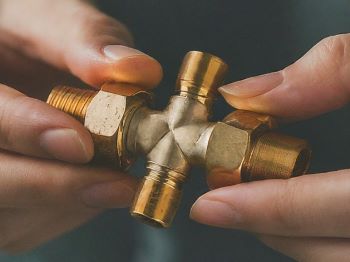In hydraulic systems, pressurized fluids power machinery. Even simple components are crucial. Hydraulic cross fittings are one such key part. They ensure smooth connections and flow direction changes in these systems.
You may be a seasoned hydraulic technician or a DIY enthusiast. You may be working on hydraulic machines. Understanding these fittings is key to success.
Types of Hydraulic Cross Fittings
The world of hydraulic cross fittings offers a variety of options to cater to different needs. Here’s a breakdown of some key variations:
A. Material Variations:
➡️ Steel: The go-to choice for durability and strength, steel cross fittings are ideal for high-pressure applications in heavy machinery.
➡️ Brass: Offering excellent corrosion resistance, brass cross fittings are well-suited for moderate pressure systems, particularly those exposed to moisture or chemicals.
➡️ Stainless Steel: Combining the benefits of both, stainless steel cross fittings provide exceptional strength, corrosion resistance, and can handle high pressures. However, they are expensive.
B. Port Connection Types:
The way hydraulic lines connect to the cross fitting is another key factor. Here are the common options:
➡️ Threaded Ports: These ports feature internal or external threads that screw onto pipes, offering a secure and easy-to-install solution.
➡️ Flanged Ports: Designed for bolting onto flat surfaces, flanged ports are ideal for high-pressure applications where leak prevention is critical.
➡️ Weld-On Ports: For a permanent, high-pressure connection, weld-on ports are welded directly onto the hydraulic lines.
➡️ Quick-Connect Ports: These innovative ports allow for easy connection and disconnection of lines, perfect for situations requiring frequent maintenance or adjustments.
C. Pressure Ratings:
Hydraulic systems operate under varying pressure levels. Choosing a cross fitting with a higher pressure rating is crucial. It must exceed your system’s pressure. This is key to safe and reliable operation. You must understand the pressure limits of materials and fitting types. This is key to making the right choice.
Choosing the Right Hydraulic Cross Fitting
Selecting the best hydraulic cross-fitting requires careful consideration of several factors:
✅ Material Compatibility:
Match the fitting material to the existing components in your hydraulic system. Steel or stainless steel might be ideal for high-pressure systems. Brass could work for moderate pressure systems with corrosion concerns.
✅ Port Size and Type:
Ensure the port size of the fitting matches the diameter of your hydraulic lines. Also, choose the right connection type. Base it on your system’s needs and accessibility.
✅ Pressure Rating:
As mentioned earlier, prioritize a fitting with a pressure rating above your system’s pressure. This prevents leaks or bursts.
✅ Flow Direction:
Consider the desired flow path through the fitting. Some cross fittings have designated inlet and outlet ports to ensure proper fluid flow direction.
Installation Tips for Hydraulic Cross Fittings
Working with pressurized hydraulic systems demands prioritizing safety. Here are some key installation tips:
1. Safety Precautions: Always relieve system pressure before working on any hydraulic components. Use the right tools and PPE, like safety glasses and gloves. Also, follow set safety protocols.
2. System Pressure Relief: Safely release any residual pressure within the system.
3. Selecting and Preparing: Choose the appropriate cross fitting and lines, ensuring cleanliness and proper thread preparation (if applicable).
4. Connection Method: Depending on the port type, proceed with threading, flanging, welding, or quick-connecting the lines to the fitting.
5. Tightening Connections: Secure all connections firmly, following the recommended torque specifications for the chosen fitting and material.
Troubleshooting Common Hydraulic Cross Fitting Issues
Even with proper installation, issues can arise. Here are some common problems and solutions for hydraulic cross fittings:
➡️ Leaks:
Identify the source of the leak – loose connections, worn seals, or damaged fittings. Tighten loose connections, replace faulty seals, or consider replacing the fitting if significantly damaged.
➡️ Flow Restrictions:
Clogged ports or an incorrectly sized fitting can restrict flow. Clean clogged ports and ensure the chosen fitting size allows for proper flow without creating bottlenecks.
➡️ Pressure Drops:
Improperly sized fittings or internal blockages can cause pressure drops within the system. Verify the fitting size is adequate and inspect for any internal blockages that might need cleaning or replacement.
Preventative maintenance practices include regularly inspecting fittings. Look for leaks and signs of wear. Also, keep the system clean. These practices can greatly reduce these issues.
Final Thought
Hydraulic cross fittings are vital. They ensure smooth flow and proper direction changes in hydraulic systems. By understanding the types, you can choose the right fitting for your needs. You must also follow the recommended methods for installing and maintaining it. This will ensure smooth hydraulic operation.
Post time: Apr-30-2024


